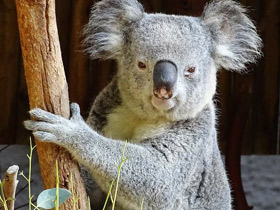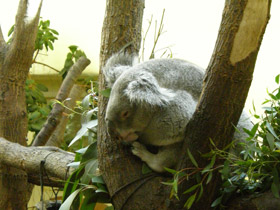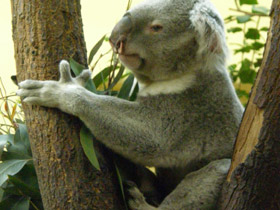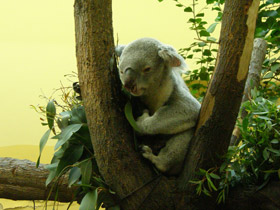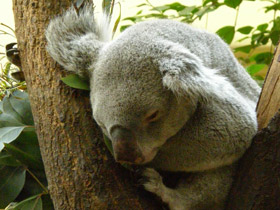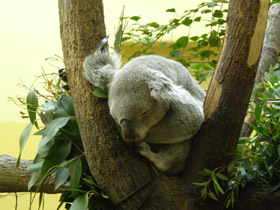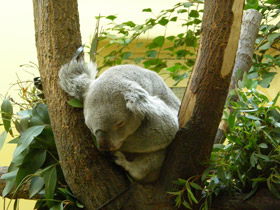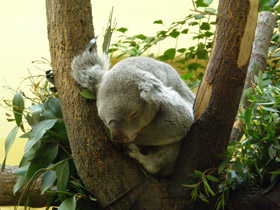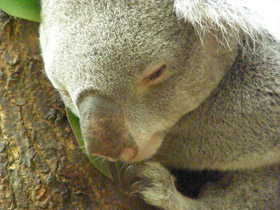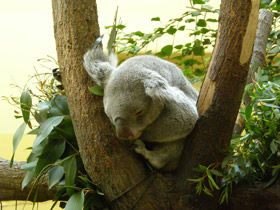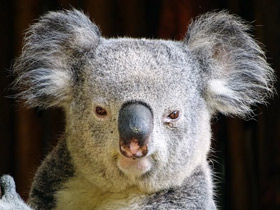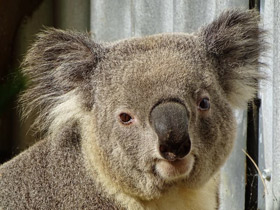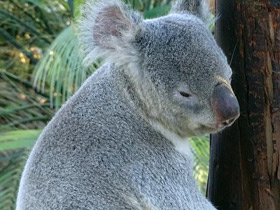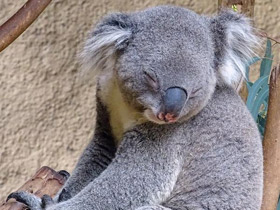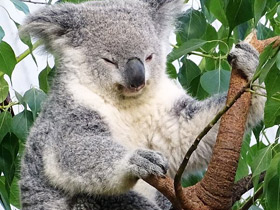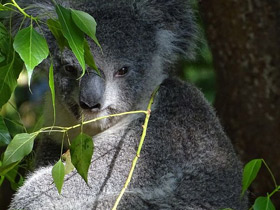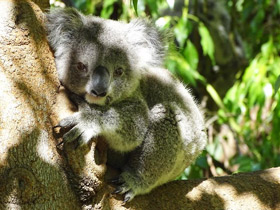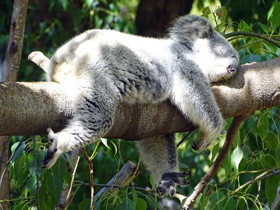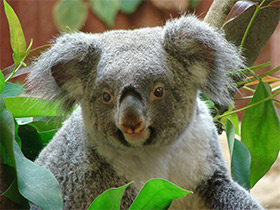The koala or koala bear (Phascolarctos cinereus) koala bear
Koala видео
The koala (Phascolarctos cinereus), sometimes called koala bear, is an arboreal herbivorous marsupial native to Australia. It is the only extant representative of the family Phascolarctidae and its closest living relatives are the wombats. The koala is found in coastal areas of the mainland's eastern and southern regions, inhabiting Queensland, New South Wales, Victoria, and South Australia. It is easily recognisable by its stout, tailless body and large head with round, fluffy ears and large, dark nose. The koala has a body length of 60–85 cm (24–33 in) and weighs 4–15 kg (9–33 lb). Fur colour ranges from silver grey to chocolate brown. Koalas from the northern populations are typically smaller and lighter in colour than their counterparts further south. These populations possibly are separate subspecies, but this is disputed.
Etymology
The word koala comes from the Dharug gula, meaning no water. Although the vowel 'u' was originally written in the English orthography as "oo" (in spellings such as coola or koolah — two syllables), the spelling later became "oa" and the word is now pronounced in three syllables, possibly in error.
Adopted by white settlers, "koala" became one of several hundred Aboriginal loan words in Australian English, where it was also commonly referred to as "native bear", later "koala bear", for its supposed resemblance to a bear. It is also one of several Aboriginal words that made it into International English, alongside e.g. "didgeridoo" and "kangaroo". The generic name, Phascolarctos, is derived from the Greek words phaskolos "pouch" and arktos "bear". The specific name, cinereus, is Latin for "ash coloured".
Taxonomy
The koala was given its generic name Phascolarctos in 1816 by French zoologist Henri Marie Ducrotay de Blainville, who would not give it a specific name until further review. In 1819, German zoologist Georg August Goldfuss gave it the binomial Lipurus cinereus. Because Phascolarctos was published first, according to the International Code of Zoological Nomenclature, it has priority as the official name of the genus. French naturalist Anselme Gaëtan Desmarest coined the name Phascolarctos fuscus in 1820, suggesting that the brown-coloured versions were a different species than the grey ones. Other names suggested by European authors included Marodactylus cinereus by Goldfuss in 1820, Phascolarctos flindersii by René Primevère Lesson in 1827, and Phascolarctos koala by John Edward Gray in 1827.
Description and distribution
Phascolarctos cinereus is a species of marsupial diprotodontid in the family Phascolarctidae, endemic to Australia. Phascolarctos cinereus is a cuddly toy-like animal with a large head with large rounded ears covered with thick fur. The eyes of Phascolarctos cinereus are small and wide apart; the thumb on the hind legs is perpendicular to the other four; the claws are strong and sharp; and the fur is thick and fluffy. Marsupials inhabit the eucalypt forests of eastern Australia, from northern Queensland to southern Victoria.
The first record of these animals appears in the report of the leader of the Blue Mountains expedition in 1798. Then, in 1802, E. F. Baraye exchanged a dead koala for a spear and tomahawk of the Australian Aborigines. In Europe, the first Phascolarctos cinereus arrived in 1880, acquired by the London Zoo. Unfortunately, the rich and beautiful fur of these animals attracted many hunters: between the early 19th century and 1924, some two million koala skins were exported. When the population of Phascolarctos cinereus declined drastically and the species became endangered, nature reserves were established in Australia, presumably to save it.
Lifestyle and nutrition
Phascolarctos cinereus spends much of its life in the foothills of eucalyptus trees, only coming down to the ground to change trees, which it cannot reach. They jump with great agility and, when fleeing, these normally slow and phlegmatic animals switch to a vigorous gallop and quickly climb the nearest tree. During the day, the Phascolarctos cinereus sleeps curled up on a branch or in the forks of branches; at night it climbs trees in search of food. Although Phascolarctos cinereus does not sleep, it usually remains perfectly still for hours, clinging to a branch or tree trunk with its forelegs. The slowness of these animals is related to their feeding habits.
Phascolarctos cinereus feeds almost exclusively on eucalyptus shoots and leaves, which are fibrous and contain little protein, while containing many substances poisonous to most animals (including hydrocyanic acid). To avoid poisoning, Phascolarctos cinereus choose to eat only eucalyptus species with fewer phenolic compounds and prefer trees growing on fertile soils (especially riverbanks), whose leaves have a lower concentration of poison than those on poor, infertile soils.
The metabolic rate of Phascolarctos cinereus is about half that of most mammals, which helps it compensate for a poorly nutritious diet. Phascolarctos cinereus needs between 0.5 and 1.1 kg of leaves per day, which it chews thoroughly and stores the resulting mass in its cheek pouches. The cecum of these animals, where digestion takes place, is highly developed and can reach a length of 2.4 m. Their digestive tract contains a large number of symbiotic bacteria that help them digest cellulose. Phascolarctos cinereus gets all the moisture it needs from eucalyptus leaves and leaf dew, so it only drinks water during prolonged droughts. To replenish its mineral deficiency, Phascolarctos cinereus occasionally eats soil.
Social behaviour and reproduction
Female Phascolarctos cinereus lead a solitary lifestyle and rarely leave their territories. Males are not territorial, but are less social: they often attack and injure each other when they meet, especially during the breeding season. It is only from October to February that Phascolarctos cinereus gather in groups consisting of one adult male and several females. During this time, males often rub their chests against trees, leaving scent marks, and emit loud calls audible from a mile away.
Gestation lasts 30-35 days and there is only one young in the litter, which is only 15-18 mm long and weighs about 5.5 g at birth. It remains in the pouch at 6 months, feeding on milk, and then "travels" on the mother's back or belly for another six months. At 30 weeks of age, the cub begins to eat its mother's semi-liquid droppings, which consist of semi-digested eucalyptus leaves; this is how the young koala's digestive tract receives the micro-organisms necessary for digestion. At one year of age, the young become independent: young females leave in search of allotments at 12-18 months, while males usually stay with their mothers until they are 2-3 years old.
Conservation
The koala was originally classified as Least Concern on the Red List, and reassessed as Vulnerable in 2014. In the Australian Capital Territory, New South Wales and Queensland, the species was listed under the EPBC Act in February 2022 as endangered by extinction. The described population was determined in 2012 to be "a species for the purposes of the EPBC Act 1999" in Federal legislation.

















